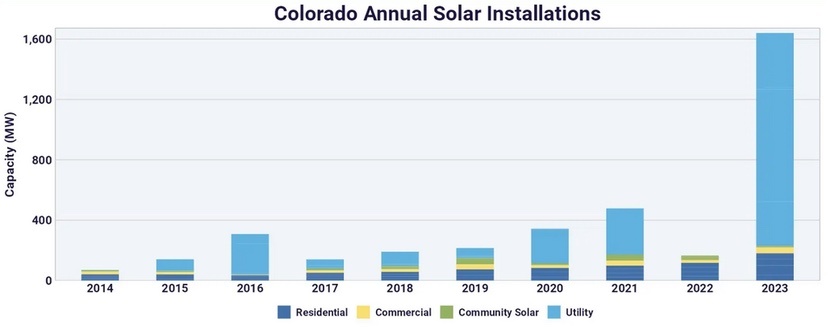The chart comes from the Solar Energy Industries Association report of March 2024. The report — which brims with interesting data — says nearly 40% of Colorado’s 4,112 megawatts of installed solar capacity was installed in 2023. And that Colorado is projected to gain another 2,835 megawatts of capacity in the next five years.

Here’s a continuation of my interview with Mike Kruger, who directs Colorado Solar and Storage Association.
If memory serves me, you came on in 2018, right?
Correct. I think my first day was October 1. Then we [his family] moved here right around Halloween. Then in the spring of 2019, my board said, we’re rebranding. We’re adding storage, so rename us, rebrand us, build a new website.
How important is that storage as a component of what you do? Do you have companies that are storage exclusive?
We have some companies that are exclusively developers of storage on a large scale.
Increasingly, we have solar folks expanding (into storage). Photon Brothers is a really good example. The company has been doing rooftop systems for maybe 10 years, and they are now the leading installer of (Tesla) Powerwalls in the state, because they’ve really leaned into that. They have a group of customers for which they know so this makes good sense.
For solar of 20 megawatts or more to be bid into a utility RFP without the option to have batteries is almost unheard of.
In places that have price signals, like time-of-use rates, we see batteries being used there and also in places that are prone to outages. So we’re definitely seeing that as an expanded business opportunity, but almost always by a solar company that’s moving into that space. The exception, like I said, we have a few large-scale companies that do only battery storage.
Looking back to before you arrived in Colorado, your predecessors spent a fair amount of time at the PUC and in meetings, trying to work toward policies. But it’s my sense that you now have two attorneys that can be engaged in the PUC process. Are there signal accomplishments that you think you’ve been able to achieve in the policy realm?
Some of the stuff I’m proudest of is still working its way through.
First, I want to be clear that I stand on the shoulders of the folks that came before me. I didn’t come into an organization that I created from scratch. We’re actually celebrating our 35th anniversary this year.
One item I’m very proud of is that we just got a tariff from Xcel and Black Hills about multi-unit net-metering so that for apartment dwellers you can put a large solar array on-site somewhere in the apartment or on the roof and the individual apartment occupants and renters can get solar credits. That’s a huge market that has not been tapped. That was a single issue that we pushed. There really wasn’t a lot of other folks pushing it. Once we got it to the Legislature and brought it to people’s attention, we picked up some allies. That’s one I’m proud of.
The most recent Xcel electric resource plan had a lot of small details, but those details add up. We’re getting 5,300 megawatts of new renewables being procured.
One of our big wins was in Xcel’s initial filing, they only wanted 400 megawatts of batteries. We forced them back to the drawing board. They are ending up buying 1,848 megawatts of batteries. So, more than four times what was originally planned.
Once you get all those batteries on the grid, we will better be able to integrate renewables. We’ll decarbonize faster. We’ll have less need for gas-peakers. And we’ll have an increasingly stable grid, right?
Batteries solve a lot of the intermittency issues that had had many utilities concerned. They don’t solve everything. I get that lithium-ion batteries have four-hour windows or six-hour windows. But four hours is better than nothing. And energy geeks like the Big Pivots readers will know that we really are only worried about four hours or thereabouts most days. Except for—
When you’re worried about a hundred hours when the wind isn’t blowing, right?
Yeah, exactly. There will be some point in the future when we have 10 days of no sun, no wind, and it will be dastardly cold or whatever. And we’ll need something bigger than that.
That’s why COSSA is involved in some of the conversations about regional markets and expanded transmissions, because it may be brutally cold here with no wind and no solar, but it won’t be in New Mexico or it won’t be in Idaho.
Hopefully we’re smart enough to grab a big geographic footprint to offset those few occasions.
Allen, there’s plenty more to do. The state is far from decarbonized. We have some policies in place, but not enough. And then we’re adding a boatload of new load (demand), right? New electrification of vehicle and fleets and industrialization and buildings. We’ve haven’t solved any of that. It’s a huge opportunity for my membership. It’s millions and millions of dollars of new private investment in mitigating climate change that we haven’t even tapped into yet.
Any workforce issues? As we talk about decarbonizing buildings, it’s brought up again and again that we don’t have the workforce familiar with heat pumps, for example.
Yes and no. Right now, solar is kind of in a steady state where we’re not hiring but we’re not firing. If you’ve been a student of this for a long time, we’ve had the “solar coaster” where we’ve ramped up and hired a bunch of folks and then the bottom dropped out and we let a bunch of folks go. Right now I think things are pretty steady state.
However, like other trades, we struggle to attract new individuals. You can make a lot of money being a crew lead or being a sales lead or a chief designer, but maybe it’s on us to do a better of communicating that. It’s not as sexy as say, going to Harvard or getting your master’s degree from CU or whatever.
All the trades have this problem. That includes plumbers and electricians. I applaud a bipartisan effort to draw attention to that through education. Honestly, though, if you wanted to become an electrician today, if you know where to look, you can do it for free. The grants are available, the training is available, and you can end up with a $150,000 job and have no debt.
What has changed? Why no workforce problems?
Interest rates, my friend. Interest rates.
Quick Facts from the SEIA report
National Ranking: 12th (4th in 2023) .
Colorado Homes Powered by Solar: 838,462 homes.
Percentage of State’s Electricity from Solar: 9.03%.
Solar Companies in State: 394 (38 Manufacturers, 182 Installers/Developers, 174 Others).
Total Solar Investment in State: $7.7 billion.
Prices have fallen 47% over the last 10 years.
Growth Projection: 2,836 MW over the next 5 years (ranks 19th).
OK, and you have to go in a minute, but let’s talk land use.
I am not totally convinced that we have a problem to solve yet. I think there is potential for conflict, whether that’s on the local community with NIMBys or the environmentalists who are worried about specific species or ecosystems. However, we don’t have them yet.
For us to be solving a problem at the Legislature that we don’t have yet feels a little premature. I know there are folks on the other side who say, well, we should solve them before they become a problem. I get a little worried about solving a problem that doesn’t exist because we might solve it in the incorrect way and create all kinds of unintended consequences. Coming up on seven weeks left in the session, we don’t have a bill yet. To my knowledge, there’s still not an agreement about what a bill should contain.
But things could move quickly – as always.
And then Mr. Kruger was off to his next meeting. The land use in question was a non-bill that has been getting a lot of attention – including from Big Pivots. See: “Should Colorado tell counties how to review renewable projects?” It would set a statewide standard for evaluating renewable energy projects by towns, cities and county governments. In late February, Sen. Chris Hansen told Big Pivots he planned to introduce it during March. As of early April, it has not.
What will have to wait are my questions about hail and solar panels. My in-house editor wants to know whether Colorado’s proclivity for hail made it somewhat less attractive to solar developers.
And then there’s the question about all those acres and acres of warehouse roofs that are proliferating along I-70 and I-76 on the eastern and northeaster edges of metropolitan Denver. What role might they place in the future?
Will they be covered with solar panels some day?
Allen Best publishes the e-journal Big Pivots, which chronicles the energy transition in Colorado and beyond.

